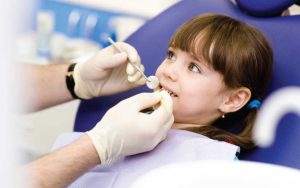A baby’s first set of teeth may not seem very important, due to the fact that they will in time fall off and make way for permanent teeth, but nothing could be more further than the truth. Find out why milk teeth matter and how you can help keep your little one’s little teeth healthy.
A baby’s milk teeth begin cutting through the gums around six months. They not only make up the most adorable toothy smiles that win over our hearts, but they also help a baby to chew when it’s time to start on solid food.
Milk teeth also have the function of setting the spacing for the next set of teeth, which are the permanent ones. Due to the fact that these milk teeth will fall out, many parents tend to not take them seriously.
The fact is, milk teeth that have decayed may have to be removed prematurely, affecting the spacing for future teeth. Ideally, milk teeth should be as healthy as permanent teeth until it’s time to fall out on their own. So, how can you help to ensure that your little one’s set of milk teeth remain healthy and not decay before their time?
Routines work best
As your baby grows into a toddler, you’ll find that anything will be easier if you make it into a routine, and this includes cleaning his teeth. Of course, it would take some patience and persistence at the initial stages, for babies and toddlers generally don’t enjoy any kind of cleaning-up activity.
After introducing the concept of teeth-brushing, you can gradually give the little one more responsibility for the brushing as time goes on, (as you supervise).
Persuade, don’t force
Persuasion is always better than force when it comes to forming good habits, so sweet talk and persuade your toddler into letting you help to brush those little teeth regularly. If your little one is still reluctant, it may help to see you brush your teeth first. An attractive toothbrush and pleasant-tasting toothpaste might make the whole idea more appealing.
Tips:
- Clean your toddler’s teeth twice a day, including once before bed.
- Use a small toothbrush with soft, round-ended bristles of differing lengths, and a small, angled head.
- Use a smear of low-fluoride toothpaste for your toddler. (You may ask your doctor for recommendations.)
- Brush using small, circular movements.
- Concentrate on one section of teeth at a time, and don’t forget the backs. Make sure you clear all traces of food from on or between those little teeth.
- Encourage your toddler to spit out any excess toothpaste.
- Bonus tip — After a sweet snack, give your little one a small piece of hard cheese to neutralise the leftover sugars in the mouth.
What you need to know about pacifiers
There’s always a good reason to have a pacifier on standby when you have a little one around, for it’s akin to an instant soother at times. However, it’s the long-term use that concerns child experts, for constant sucking on a pacifier is found to affect how teeth line up. The pacifier is also known to cause changes in the shape of a little one’s mouth.
Your child’s diet matters too
A lot of the foods and drinks that keep your toddler in good general health are also good for your little one’s teeth, so be sure to offer your child a balanced diet with plenty of fruits and vegetables.
Calcium will help your toddler grow strong bones and teeth. Leafy green vegetables, nuts, and soya are good sources of calcium. You should also make sure your toddler’s diet contains plenty of vitamin D, which will help that little body to absorb more calcium. Good sources of vitamin D include oily fish, milk, and eggs.
Limit the sugary stuff
Sugar combines with the bacteria in the mouth to make a mild acid that attacks the hard outer layer of our teeth, making them vulnerable to decay and cavities. The more times a day your toddler eats something sugary, and the longer the sugar stays in the mouth, the more likely it is that damage will occur. Cleaning those little teeth after each meal and keeping sweets, cakes, chocolate, and other high-sugar snacks to a minimum between meals will help minimize the risk of tooth decay. Instead, encourage healthy, tooth-friendly snacks, such as vegetable sticks, fruit, and yogurt.

Visiting the dentist
Most first teeth have nearly a decade of hard work in front of them. Good oral care, including attention and care of a dentist early on, will lay the foundations for a lifetime of healthy teeth. Dentists can help to prevent, as well as cure, teeth problems. So don’t wait until you see signs of tooth decay or until you think your toddler’s teeth need help before taking your child to see a dentist. Taking your toddler to the dentist from a young age with help get the little one used to the environment of a dentist’s office. Taking your child to your appointments will help too.
Make the visit fun and positive, even if you aren’t a fan of the dentist yourself. Dentists have lots of experience in making children feel welcome and comfortable. They may even offer your toddler a little reward at the end of the appointment.


